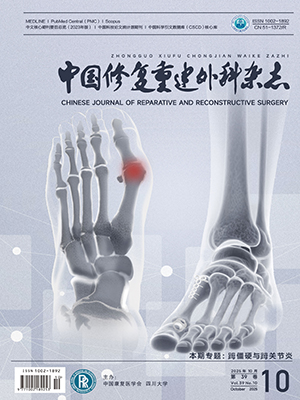Objective To explore the morphological characteristics of the postero-superior protuberance of the calcaneus and to explore its relationship with Haglund malformation. Methods Ankle lateral X-ray films of 391 hospitalized patients between May 2021 and June 2024 were retrospectively collected. The morphological parameters of the postero-superior protuberance of the calcaneus were measured, including the length of the base, the height of the base, and the tip angle of the postero-superior protuberance of the calcaneus, and the morphological types were classified according to the above parameters, including the peak type, the hill type, and the flat type. The related parameters of Haglund malformation were measured, including Fowler-Philipp angle (FPA), calcaneal pitch angle (CPA), parallel pitch line (PPL), Chauveaux-Liet angle (CLA), and X/Y ratio (total calcaneal length/length of greater tuberosity of calcaneus). The differences of the morphological parameters of the postero-superior protuberance of the calcaneus and the related indicators of Haglund deformity among the three types and between the males and the females were compared and analyzed, and the differences of the positive numbers of the related indicators of Haglund deformity among the three types were compared. Results According to the morphological parameters of the postero-superior protuberance of the calcaneus, there were 64 cases of peak type, 245 cases of hill type, and 82 cases of flat type. There was no significant difference in the length of the base of the postero-superior protuberance of the calcaneus, CPA, CLA, and X/Y ratio among the three types (P>0.05). Among the three types, the peak type had the largest FPA and the flat type had the smallest (P<0.05); the peak type had the smallest tip angle of the postero-superior protuberance of the calcaneus and the flat type had the largest (P<0.05); the positive rate of PPL in the hill type was significantly higher than that in the peak type and flat type (P<0.05); the height of the base of the postero-superior protuberance of the calcaneus in the flat type was the smallest (P<0.05). FPA, CPA, CLA, PPL, and X/Y ratio were positive in 2, 42, 172, 142, and 77 patients, respectively. There was no significant difference in the number of positive Haglund deformity indicators among the three types (P>0.05). There was no significant difference between male and female patients in the tip angle of the postero-superior protuberance of the calcaneus, FPA, the positive rate of PPL, and X/Y ratio (P>0.05). The length and the height of the base of the postero-superior protuberance of the calcaneus, CPA, and CLA in male patients were significantly higher than those in female patients (P<0.05). Conclusion The postero-superior protuberance of the calcaneus can be divided into three types: the peak type, the hill type, and the flat type. The peak type is more likely to suffer from Haglund deformity, and the males are more likely to suffer from Haglund deformity than the females.
Citation:
ZHANG Lei, ZHANG Man, JIANG Lu, HUANG Lei, WU Yu, LENG Rao, SHI Houyin, WANG Guoyou. Morphological classification of postero-superior protuberance of calcaneus and its relationship with Haglund deformity. Chinese Journal of Reparative and Reconstructive Surgery, 2025, 39(5): 592-597. doi: 10.7507/1002-1892.202502021
Copy
Copyright © the editorial department of Chinese Journal of Reparative and Reconstructive Surgery of West China Medical Publisher. All rights reserved




